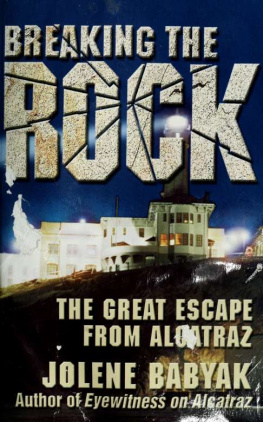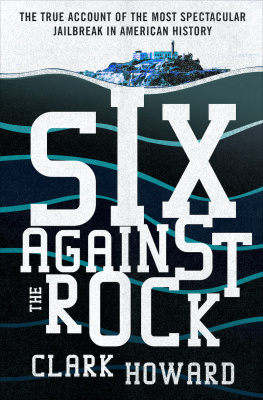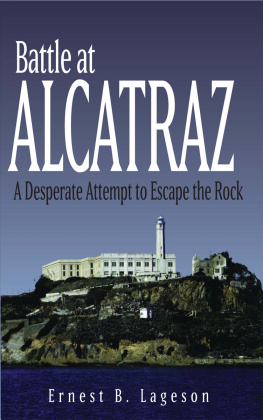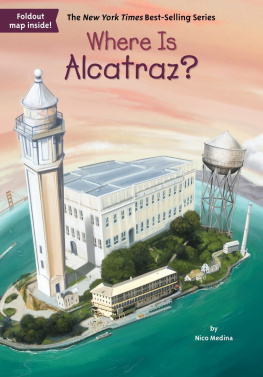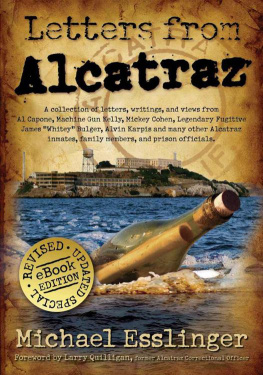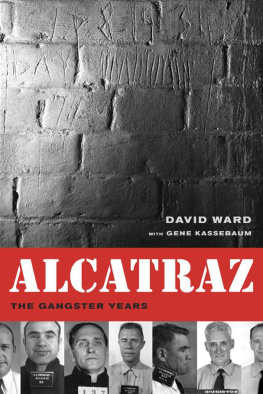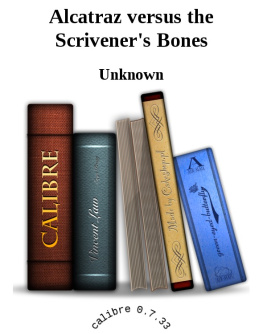Jolene Babyak - Breaking the Rock: The Great Escape from Alcatraz
Here you can read online Jolene Babyak - Breaking the Rock: The Great Escape from Alcatraz full text of the book (entire story) in english for free. Download pdf and epub, get meaning, cover and reviews about this ebook. year: 2001, publisher: Ariel Vamp Press, genre: Non-fiction / History. Description of the work, (preface) as well as reviews are available. Best literature library LitArk.com created for fans of good reading and offers a wide selection of genres:
Romance novel
Science fiction
Adventure
Detective
Science
History
Home and family
Prose
Art
Politics
Computer
Non-fiction
Religion
Business
Children
Humor
Choose a favorite category and find really read worthwhile books. Enjoy immersion in the world of imagination, feel the emotions of the characters or learn something new for yourself, make an fascinating discovery.
- Book:Breaking the Rock: The Great Escape from Alcatraz
- Author:
- Publisher:Ariel Vamp Press
- Genre:
- Year:2001
- Rating:4 / 5
- Favourites:Add to favourites
- Your mark:
- 80
- 1
- 2
- 3
- 4
- 5
Breaking the Rock: The Great Escape from Alcatraz: summary, description and annotation
We offer to read an annotation, description, summary or preface (depends on what the author of the book "Breaking the Rock: The Great Escape from Alcatraz" wrote himself). If you haven't found the necessary information about the book — write in the comments, we will try to find it.
Breaking the Rock: The Great Escape from Alcatraz — read online for free the complete book (whole text) full work
Below is the text of the book, divided by pages. System saving the place of the last page read, allows you to conveniently read the book "Breaking the Rock: The Great Escape from Alcatraz" online for free, without having to search again every time where you left off. Put a bookmark, and you can go to the page where you finished reading at any time.
Font size:
Interval:
Bookmark:

This book made available by the Internet Archive.






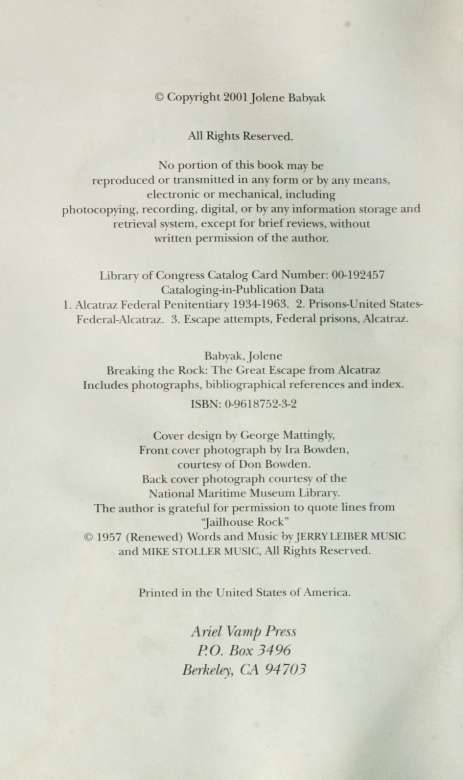
To the L.T.M.
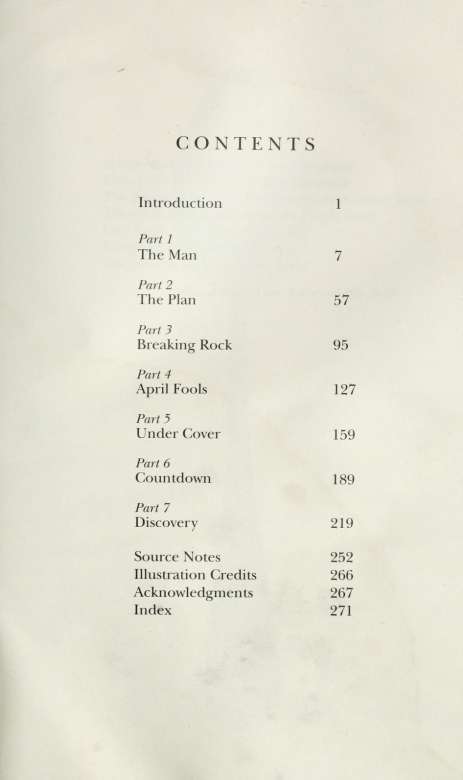
Spider Murphy played die tenor saxophone
Litde Joey's blowing on die slide trombone
The drummer boy from Illinois went crash, boom, bang
The whole rhythm section was the Purple Gang.
Let's Rock! Everybody Let's Rock!
Everybody in the old Cell Block,
Was Dancing to the Jailhouse Rock!
"Jailhouse Rock " by Jerry Leiber and Mike Stoller

Introduction
DID THEY MAKE IT?
Sure offAlcatraz Island. That much we know.
The rest of itthe facts, the evasions and the cover-ups that made up the initial investigation; the telephone calls, postcards and letters, which masqueraded as evidence; the sightings of men on a raft, of men resembling the escapees in New Orleans, Washington D.C., Rio de Janeiro and Canada; the alleged appearance of mysteriously veiled, heavily made-up women, or bearded men, who showed up at family funerals; the movie myths, the urban myths, and the rumors of boat pickups based on little but a con's nodhave all made the 1962 escape from Alcatraz one of the most enduring mysteries of the twentieth century.
And it all began for me at my house on Alcatraz Island at 7:15 A.M. on June 12 when the telephone rang with a shrill, angry summons.
The institution's phone was one of those old, stand-up, cradled black phones hardwired into the wall with a heavy, nappy cord. My father, Arthur M. Dollison, eight months into his newjob as associate warden, had been "acting warden" for almost two weeks while Warden Olin G. Blackwell was away on vacation. Dad stepped to the desk and reached for the phone with dread. He knew it couldn't be good news. He listened as the control room officer said that three dummy masks had been found in the cell house. Uttering a profanity I had never heard fall from his lips, he stormed out of the house, and put into motion one of the largest manhunts since the 1932 Charles Lindbergh baby kidnapping.
I was fifteen that summer and upstairs still asleep. Within seconds of my father's departure from our house, a loud, piercing siren woke me. I tumbled down the stairs as my mother met me, telling me to get dressedthere had been an escape. I was thrilled; I was going to be late for school but I had a terrific excuse.
VIEWED FROM A Landsat camera, San Francisco Bay barely shows up. But forty percent of California's waterways drain into itmostly snow runoff from the Sierra Mountains gushing down fourteen tributaries into the Sacramento and San Joaquin Rivers. These rivers in turn drain into the bay and eventually mix with the tides flowing under the Golden Gate Bridge and out into the Pacific Ocean.
If you place your left hand in front of your face, fingers together, palm away, your thumb becomes the peninsula of the city of San Francisco. Alcatraz Island would only be a millimeter from your thumbnail. Most people wonder how the most maximum-security federal prison in the United States gained its "escape proof" reputation when it's so close to San Francisco you could almost reach out and touch it. In fact, it's only a mile and a quarter from the city. But if your thumb is San Francisco, then your index finger would be the Golden Gate Bridge, three miles from Alcatraz, and the rest of your hand would be the Pacific Ocean. Someone standing ninety-seven feet from you with his right hand in front of his face would represent the next piece of land. That would be Hawaii.
Alcatraz is a twenty-two acre, battleship-shaped rock, made out of sandstone. Tides flow across its port and starboard sides on their way to and from the Pacific Ocean.
Continuing with our hand geography, if you take your right hand, palm away, and form a loose triangle with your thumbs and index fingers, your right hand becomes the East BayOakland, Berkeley and beyond. The bridge that connects San Francisco to the East Bay The San Francisco-Oakland Bay Bridgeis three miles from Alcatraz, but land on that side can be as far as eight miles away.
Meaning that if you swim from Alcatraz to San Francisco you'd better pick slack tidethe quiet time between the tides when the sea is neither rushing into the bay for high tide nor cascading out resulting in low tide. That's the moment when the ferocious currents, the speed and the angle are the most beneficial for swimming to land. And if it's your first time swimming San Francisco Bay you'd better wear a cap, and maybe a wet suit, because the bay's temperature runs a close second in risk factor behind the tides. It's a cold, cold bayabout forty-eight to fifty-four degrees Fahrenheit, or nine to twelve degrees Celsius, year around. Some good swimmers cannot tolerate being in the bay more than forty-five minutes before they
are so chilled they must get out, their body temperature so low they begin to feel the affects of hypothermia. Yet despite that, every year hundreds of people swim from Alcatraz to San Francisco in two large, friendly meets. Those prisoners could have made it. That much we also know.
And between those two possibilities lies a story that I felt compelled to examine.
"Did they make it?" is the most commonly asked question at the National Park on Alcatraz today. And there are strong arguments for both answers. But that's never been the most compelling question for me. How did they do it? How did they amass all the tools and keep them hidden for months? How did they dig through concrete without the holes being discovered? How did they turn common prison clothing into life jackets and a raft? The 1962 escape from Alcatraz remains one of the most well-planned and elaborate escape attempts in U.S. history. How did my father; the captain who lived next door to us; the lieutenants, whose children were friends of mine; and the officers, whose lives and the lives of their families depended on their vigilance, not see this escape coming?
In researching this book I discovered that two parallel stories existed. There was the escape, of course, with all its fascinating, cunning details, but there was another story as equally determined. And like railroad tracks moving toward a vanishing point, the two stories converged in an almost fated way that broke "the Rock."
THE READER WILL see that I have taken some liberties in telling this story. Although I have been interviewing Alcatraz officers and prisoners since 1978, by the time I began to research this book all the principals were dead or missing. And because other men who were close to the escapees or worked inside the prison didn't participate in the attempt, nor see the work being done, nor view some of the handmade products, nor always tell the truth, I had to distinguish between facts, rumors, lies, and myths. One of my first challenges, for example, was translating the common words used by the informants, and the original investigators, to describe the tools used and the methods incorporated to break out of the building. In the end, I not only relied on the investigative reports, prisoner files, original photographs and interviews with men who were there, but
Font size:
Interval:
Bookmark:
Similar books «Breaking the Rock: The Great Escape from Alcatraz»
Look at similar books to Breaking the Rock: The Great Escape from Alcatraz. We have selected literature similar in name and meaning in the hope of providing readers with more options to find new, interesting, not yet read works.
Discussion, reviews of the book Breaking the Rock: The Great Escape from Alcatraz and just readers' own opinions. Leave your comments, write what you think about the work, its meaning or the main characters. Specify what exactly you liked and what you didn't like, and why you think so.

